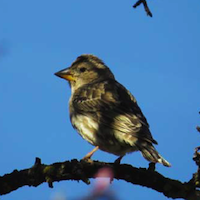Habitat use during post-pre-breeding period in a Rock Sparrow Petronia petronia population

All claims expressed in this article are solely those of the authors and do not necessarily represent those of their affiliated organizations, or those of the publisher, the editors and the reviewers. Any product that may be evaluated in this article or claim that may be made by its manufacturer is not guaranteed or endorsed by the publisher.
Accepted: 30 March 2020
Authors
Most studies focusing on Rock Sparrow populations concern their breeding biology. With this study, we aim to investigate the wintering habitat and social behaviour outside the breeding period. In the study area the species is present all year long, and, outside the breeding period, birds frequently gather together on flocks of different size (3-150 individuals), which are larger in the coldest months. The habitat types most used by the species were cereal fields with crops in their first stage of development (17.71% ± 4.72 Standard Deviation) and arable stubbles, both of them with bushes and trees on their boundaries (82.4%), which likely provide shelters from predators. The bird species most frequently associated with Rock Sparrow flocks were Tree Sparrow, Starling and Crested Lark. Holes in the roof tiles of the same abandoned buildings used for breeding were also used as night shelters. The average hours of leaving and returning to the shelters was strictly related to the photoperiod (rs = -0.9405; 0.8810).







